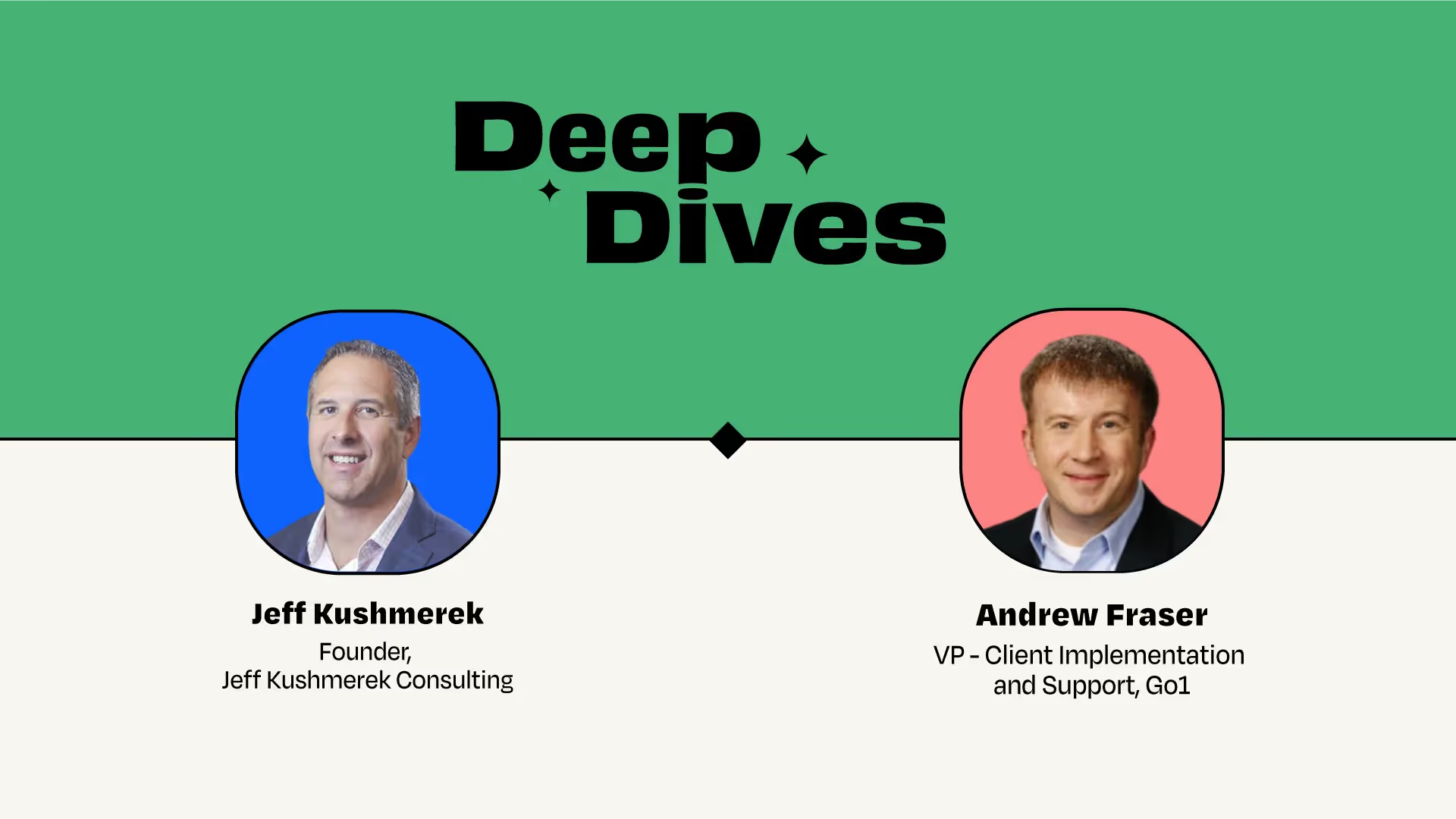Jeff Kushmerek, Founder of Jeff Kushmerek Consulting, and Andrew Fraser, VP - Client Implementation and Support at Go1, joined Srikrishnan Ganesan of Rocketlane for our second Deep Dives session.
Jeff works with SaaS B2B CEOs to help them reduce customer churn and significantly increase their recurring revenue and software adoption. With 20+ years of experience in customer onboarding, his proven process provides guaranteed results that will increase customer retention.
Andrew has 20+ years of experience leading Customer Success and Implementation teams. His stints include companies like Concur and PayScale. He is currently at Go1, a Brisbane-based startup.
Key takeaways from the session are below.
Involving the customer implementation team in the pre-sale journey
Involve the customer implementation team when the sales journey reaches the 75% mark, i.e., when the prospect has decided to use your product. Get them to have a 45-minute call to understand the data migration aspects, timelines, etc., before sending the deal contract to the customer.
However, before the implementation team jumps in, encourage the sales teams to have a canned answer that says that you have a methodology and have done this many times before, but there are always a few outliers. This lets the customer start digging a little bit deeper. Also, look for indicators of whether the customer has a more complicated scope or that they're above your average deal size. In these situations, it's helpful to involve those responsible for delivery. It helps set up the customer so that they are confident that they can move forward.
Materials and resources to showcase to your customers
To build confidence, showcase your onboarding and implementation approach or methodology to your customers so that they conceptually understand the phases they’ll go through during the implementation.
Help your customer understand what type of organization you are and how they can expect to work with you. Introduce your project managers, technical consultants, and change agents who might play a part in this.
Walking them through a simple project plan helps them understand what you’re going to do together. For customers who want to go outside your standard implementation approach, use the project plan as a framework to manage the scope around what you can do and what’ll make you uncomfortable.
Do an exercise with your customers where you bring an architect or developer who’ll answer the customer’s questions. This helps set the stage about expectations on the timeline and perhaps understand where you can charge more.
Ask smart questions from the start of the pre-sale process, which will show your customer that you know what you’re talking about. You can bridge the gap and be that resource to hear what the prospect wants to do and map it to knowing your software.
A 'Readiness Kit' for customer onboarding
Advice for early-stage startups and companies focusing on a new target market
Fake it till you make it.
Take a consultative approach by asking smart questions.
Create a joint success plan mapping out what they’ll do with your software and not just focus on functionality and features. Present this plan during the kick-off meeting, and clearly outline what you’re going to deem as live and successful.
Get the implementation team involved earlier in the pre-sale process to understand more about the relevant experiences and make the customer feel comfortable during the implementation process. Create a few collaterals together from implementation and sales, and do proof of concepts throughout the sales cycle.
Ideas to introduce your implementation team
The trump cards: Each member of the implementation team has a card that introduces them, shows their stats on the implementation they’ve done, their average time-to-value, and other achievements. This will help the customer to understand and connect with people who aren’t present in the meeting.
Handling conversations around the success plan
Firstly, approach it from the customer’s business objectives that they’re trying to achieve with your product. Get to know who’re the sponsors, champions, and users.
Secondly, understand what change management aspect you need to approach and get your champions to advocate for your product.
If your customer has a particular process that they’ve to follow, and your team can’t afford to make those big changes, then hold your ground.
Strategies to tackle and estimate customer readiness for implementation
Actively listen to the customer. When you're presenting what you’re going to do and what resources you have, and the scope you agree on, you must also ask the customer what resources they have, what resources they'll need, and the level of guidance they want. And if you don't have that, then you can't be confident in showcasing the timeline. The whole point of setting expectations is to have a realistic goal around the timeline so that you are mutually successful.
If you're more about the template approach, you can share the material on how much time it typically takes. And the team has a project manager, a technical expert, when they’ll get involved, and how much time it typically takes for this integration or for that data set.
Get customers ready to work on a project by letting them know the implementation cost. Share a written contract mentioning the scope duration and processes that will give them the mindset not to ghost or delay sending files. This will protect you when the scope becomes longer, and they’re not going live as expected, also saves your team from burnout. Set those expectations in pre-sales with open and honest conversations.
Also, if the customers don’t show up to meetings, have a formalized process to put that implementation on hold. When they’re ready to restart, let them know they might not get the same resources due to unavailability. You might not need to explain this pre-sale, but definitely during kick-offs explaining how you’ll be operating together.
How to build the right dynamic with the sales team
Spend some time with the sales team before meeting with the customer. Firstly, set up some rules of engagement. Become aware of what the sales team has promised before you go into the conversation with the prospect and then draw up some boundaries.
For instance, if the prospect asks if the product can do something or if you can do the implementation faster, the sales rep might want to say yes. But, there's a reason why it takes three months or six weeks and not three days. So, the implementation resources must become the voice of reason in these conversations and bring things back to reality.
Change management process during the pre-sale stage
Bring up the change management that needs to be done at the end of the kickoff meeting while discussing risks. Sometimes it comes up in the sales cycle, but it tends to be only if a customer asks what can go wrong, what they should look out for, and you should be far enough along in the sales cycle to have this conversation.
What to include in a kickoff deck that you did not include in the pre-sale meeting
During pre-sales, start by presenting your implementation framework. But for kick-offs, with the pre-sales deck, add a few more slides that include how you do the implementation, meeting schedules, any details about integrations, your project management plan, and the tools to handle that, etc. This shows certainty and visibility throughout the process and helps you outline the available resources for the customer.
Handling bugs that delay the go-live
As soon as you find a bug that could be a potential risk, bring it up to the concerned team members. If it’s not critical, check if you can hide this feature for now. It’s better to have an escalation process that helps to prioritize these huge implementation blocks. To have this kind of mechanism in place, it’s crucial to build relationships with your product and engineering teams.
Apart from milestones to go live, how the customer can realize value
A lot of teams don’t do until the customer implementation is done conducting executive or quarterly business reviews. But doing monthly EBRs or QBRs will help the customer realize the little wins such as what they’ve achieved, what they learned, etc.
In case the channel partner implementation, how do we track and engage as her principal company, what's the best practice in most cases, we don't get visibility from the partners.
Value Realization for SaaS Businesses: Framework and Tools
Best practices to track and engage channel partners
Unless you've got a repeatable, easy-to-train method to get a partner team up and running, get your team in order before you start outsourcing it to other people.
Have a formal way to bring these people in and assign an internal resource to make sure the partners have somebody reach out if in need of help. They should be treated like any other department in the company.
Make sure your partners are discovering things that need to be fixed, such as product bugs that delay the go-live. You also need to give them status updates and train them on all new feature releases.
If you’ve any additional strategies you want to share, we’d love you to join our Preflight Community and share it with all our community members!















